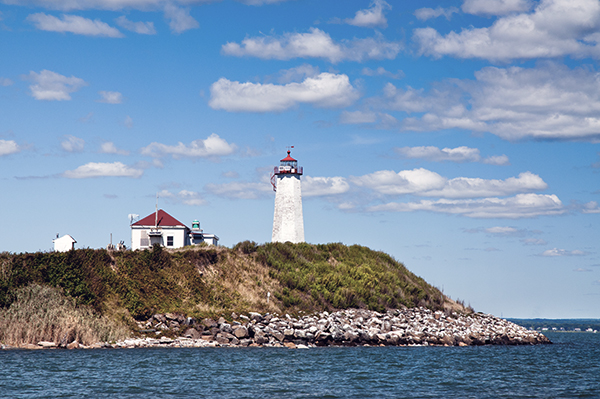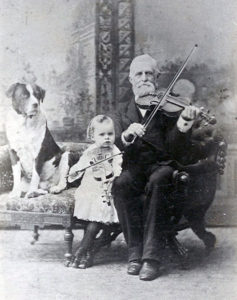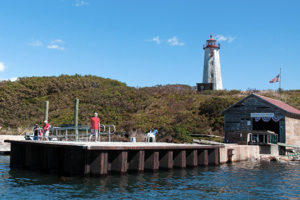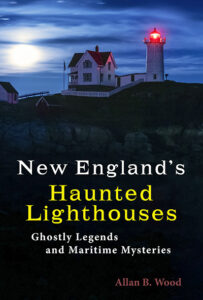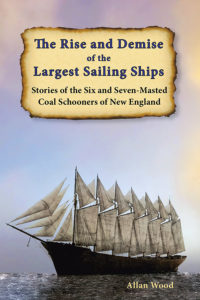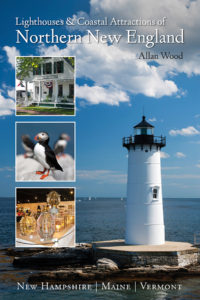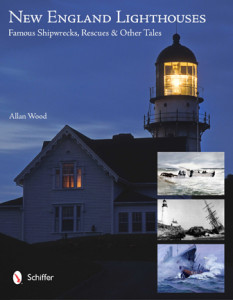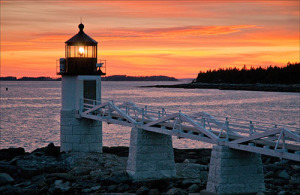Oliver Brooks: One of New England’s Most Talented Lighthouse Keepers at Faulker’s Island Light In Connecticut
Connecticut’s second oldest lighthouse, Faulkner’s Island Lighthouse was built in 1802 due to the many shipwrecks around the island. Even with the lighthouse established, although the light saved many, many shipwrecks occurred over the years. It was located about four miles from the main shoreline and was within one-mile distance of a tiny island known as Bruce Island.
Keeper Oliver Brooks was known to be one of the most experienced, colorful, and talented keepers in New England. He played the violin, studied ornithology and taxidermy, and conducted experiments with sound and light. He often practiced his taxidermy skills on many unfortunate birds that would be attracted to the reflecting beacon, collide with the lighthouse lantern, and die. The keeper’s house became a natural history museum and a regional attraction for visitors. As a taxidermist, he had plenty of local birds and migrating birds that suffered fatal crashes into the lantern windows. His collection also included eagles, cormorants, ducks, a seal, a fox, an ox, and a rare great snowy owl from the Arctic. The story goes that when he shot the owl in the neck area, it was so maimed that he found a rooster’s head and used part of it to fill what was missing on the owl’s head and shoulders. One of his daughters reportedly shot several birds to add to the collection.
He was an avid farmer on the island with plenty of barnyard farm animals, including a mule, cows, and chickens. Many times, the animals would try to escape and attempt to swim or fly from the island, where he had to retrieve them back to the barn. Local fishermen and lobstermen sometimes would find one of the cows trying to swim and direct them back to the island for the keeper. He also made a living as a large-scale fisherman and lobsterman and sold his catch to the locals on the mainland or visitors on the island. The family ate lobster as a mainstay almost daily.
The entire Brooks family enjoyed playing musical instruments and would treat visitors to concerts at the lighthouse. Brooks himself enjoyed playing the violin. His oldest daughter studied marine botany and painted using watercolors. Brooks also had a huge dog named Old Tige, whom he taught to sing after his daughter would play the flute. It was written that the dog’s voice was not in long drown howls or short barks but an extraordinary something in between. His wife and both daughters appreciated artwork and were painters themselves.
Brooks was also an excellent communicator. He used the sun reflected into a mirror-like device known as a heliograph to communicate with friends on hilltops on the mainland up to 15 miles away in broad daylight. Years later, the heliograph was used from the mainland to communicate with him when Lincoln was assassinated.
Captain Brooks also owned nearby Bruce Island, about a mile away, where he would row out to hunt with Old Tide. It was his other getaway if he had the opportunity from Faulkner’s Island.
He was an expert at handling small boats in all kinds of weather and was known for his extraordinary skills, especially in helping with rescue efforts. The small craft he used from Faulkner’s Island was an 18-foot skiff with a sail and long oars.
Oliver N. Brooks served as keeper at Faulkner’s Island Lighthouse from 1851 to 1882. Nearly one hundred vessels were wrecked in the vicinity during his tenure due to the extreme weather conditions surrounding the island, not from the lighthouse itself or the lighthouse keeper. He is credited with assisting in 71 of these events, whether the vessels were destroyed or partially wrecked. Two of his most famous rescues involve the wreck of the Moses F Webb and, years later, the E. A. Woodward.
Exploring Faulkner’s Island Lighthouse
Today, the lighthouse is being gradually protected and saved by the Faulkner’s Light Brigade organization. They restored much of the lighthouse in 1999, with restoration efforts continuing. Faulkner’s Island is part of the Stewart B McKinney Wildlife Refuge. It has become a protected bird sanctuary, so visitors are not allowed, except in the early fall, usually around August, where there is an annual open house for the public to explore the grounds and lighthouse, promoted with transportation provided by the Faulkner’s Light Brigade out of Guilford Harbor. It is an excellent opportunity to visit the tower and learn about the birds protected by the naturalists who work there.
Here are some of my photos of Faulkner’s Island Lighthouse.
For more information or to donate to restoration efforts, contact the Faulkner’s Light Brigade, P.O. Box 199, Guilford, Connecticut 06437.
Phone: (203) 453-8400
Faulkner’s Light Brigade Website
Enjoy the tour this summer!
Allan Wood
Books to Explore
New England’s Haunted Lighthouses:
Ghostly Legends and Maritime Mysteries
Discover the mysteries of New England’s haunted lighthouses! Uncover ghostly tales of lingering keepers, victims of misfortune or local shipwrecks, lost souls, ghost ships, and more. Many of these accounts begin with actual historical events that later lead to unexplained incidents.
Immerse yourself in the tales associated with these iconic beacons!
The Rise and Demise of the Largest Sailing Ships:
Stories of the Six and Seven-Masted Coal Schooners of New England.
In the early 1900s, New England shipbuilders constructed the world’s largest sailing ships amid social and political reforms. These giants were the ten original six-masted coal schooners and one colossal seven-masted vessel, built to carry massive quantities of coal and building supplies and measured longer than a football field! This self-published book, balanced with plenty of color and vintage images, showcases the historical accounts that followed these mighty ships.
Available also from bookstores in paperback, hardcover, and as an eBook for all devices.

Book – Lighthouses and Coastal Attractions in Southern New England: Connecticut, Rhode Island, Massachusetts
Lighthouses and Coastal Attractions of Southern New England:
Connecticut, Rhode Island, and Massachusetts.
This 300-page book provides memorable human interest stories from each of the 92 lighthouses, like the story of Oliver Brooks at Faulkner’s Island Light in Connecticut. You can explore plenty of indoor and outdoor coastal attractions, including whale-watching excursions, lighthouse tours, windjammer sailing tours, parks, museums, and even lighthouses where you can stay overnight. You’ll also find plenty of stories of hauntings around lighthouses.
Lighthouses and Coastal Attractions of Northern New England:
New Hampshire, Maine, and Vermont.
This 300-page book provides memorable human interest stories from each of the 76 lighthouses. It also describes and provides contact info for plenty of indoor and outdoor coastal attractions and tours. These include whale watching, lighthouse tours, unique parks, museums, and lighthouses where you can stay overnight. There are also stories of haunted lighthouses in these regions.
New England Lighthouses:
Famous Shipwrecks, Rescues & Other Tales
There are over 40 stories, including Oliver Brooks’s rescue of Faulkner’s Island Lighthouse. This image-rich book also contains vintage images provided by the Coast Guard and various organizations and paintings by six famous Coast Guard artists.
You can purchase this book and the lighthouse tourism books from the publisher Schiffer Books or in many fine bookstores such as Barnes and Noble.
Join, Learn, Support The American Lighthouse Foundation
Copyright © Allan Wood Photography; do not reproduce without permission. All rights reserved.
